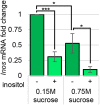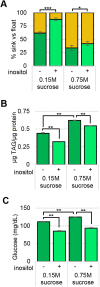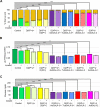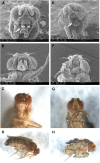Regulated inositol synthesis is critical for balanced metabolism and development in Drosophila melanogaster
- PMID: 34710213
- PMCID: PMC8565467
- DOI: 10.1242/bio.058833
Regulated inositol synthesis is critical for balanced metabolism and development in Drosophila melanogaster
Abstract
Myo-inositol is a precursor of the membrane phospholipid, phosphatidylinositol (PI). It is involved in many essential cellular processes including signal transduction, energy metabolism, endoplasmic reticulum stress, and osmoregulation. Inositol is synthesized from glucose-6-phosphate by myo-inositol-3-phosphate synthase (MIPSp). The Drosophila melanogaster Inos gene encodes MIPSp. Abnormalities in myo-inositol metabolism have been implicated in type 2 diabetes, cancer, and neurodegenerative disorders. Obesity and high blood (hemolymph) glucose are two hallmarks of diabetes, which can be induced in Drosophila melanogaster third-instar larvae by high-sucrose diets. This study shows that dietary inositol reduces the obese-like and high-hemolymph glucose phenotypes of third-instar larvae fed high-sucrose diets. Furthermore, this study demonstrates Inos mRNA regulation by dietary inositol; when more inositol is provided there is less Inos mRNA. Third-instar larvae with dysregulated high levels of Inos mRNA and MIPSp show dramatic reductions of the obese-like and high-hemolymph glucose phenotypes. These strains, however, also display developmental defects and pupal lethality. The few individuals that eclose die within two days with striking defects: structural alterations of the wings and legs, and heads lacking proboscises. This study is an exciting extension of the use of Drosophila melanogaster as a model organism for exploring the junction of development and metabolism.
Keywords: Developmental defect; Head; Inositol; Metabolism; Obesity; Proboscis.
© 2021. Published by The Company of Biologists Ltd.
Conflict of interest statement
Competing interests The authors declare no competing or financial interests.
Figures






References
-
- Basak, P., Sangma, S., Mukherjee, A., Agarwal, T., Sengupta, S., Sudipta, R. and Majumder, A. (2018). Functional characterization of two myo-inositol-1-phosphate synthase (MIPS) gene promoters from the halophytic wild rice (Porteresia coarctata). Planta 248, 1121-1141. 10.1007/s00425-018-2957-z - DOI - PubMed
Publication types
MeSH terms
Substances
Grants and funding
LinkOut - more resources
Full Text Sources
Molecular Biology Databases
Research Materials
Miscellaneous

